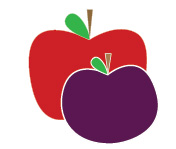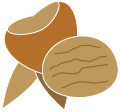A person’s brain is said to not reach full maturity until the age of 25. However, 90 percent of the brain develops by his/her fifth birthday and the brain continues to rapidly create synapses (brain cell connections) throughout their childhood and teen years.
Because of these critical brain development periods, it is essential to maintain good nutrition for brain development — especially in order to maintain good performance in the classroom. Let’s put it this way, the brain works as an engine; the better the fuel, the better it will run. There are foods that are particularly great fuel for the brain and are proven to show improvement in brain function as well as performance in the classroom.
Here are a list of some foods that are easy to incorporate into a child’s lunchbox that should be recommended to students and parents:
Apples & Plums:
 Children love sweets and often crave them for short spurts of energy (aka: sugar rush). Their bodies want sugar but need fructose and fiber (both of which are prominently found in fruits). Apples and plums are special since they both contain the antioxidant, quercetin. Quercetin has been proven to improve memory and to help decrease the decline in brain function later on in life, and even help prevent Alzheimer’s disease. However, a lot of the nutrition in these fruits are in the skin of fruit.
Children love sweets and often crave them for short spurts of energy (aka: sugar rush). Their bodies want sugar but need fructose and fiber (both of which are prominently found in fruits). Apples and plums are special since they both contain the antioxidant, quercetin. Quercetin has been proven to improve memory and to help decrease the decline in brain function later on in life, and even help prevent Alzheimer’s disease. However, a lot of the nutrition in these fruits are in the skin of fruit.
Nuts & Seeds
 Chips and crackers are often a favorite among kids. A nutritious way to get in their salty craving is the consumption of nuts and seeds. Nuts and seeds are filled with protein, essential fatty acids, and vitamins and minerals; all of which are important for brain development. These nutrition benefits may boost children’s moods and keep their nervous system happy. If they are happy, the teacher’s job is a lot easier.
Chips and crackers are often a favorite among kids. A nutritious way to get in their salty craving is the consumption of nuts and seeds. Nuts and seeds are filled with protein, essential fatty acids, and vitamins and minerals; all of which are important for brain development. These nutrition benefits may boost children’s moods and keep their nervous system happy. If they are happy, the teacher’s job is a lot easier.
Dark green vegetables
 Spinach and Kale contain sulforaphane, a molecule that has detoxifying abilities, and dindolylmethane, which helps new brain cells grow. Leafy greens are also packed with folate and vitamins have been linked to decreasing the chances of being diagnosed with dementia later on in the child’s life.
Spinach and Kale contain sulforaphane, a molecule that has detoxifying abilities, and dindolylmethane, which helps new brain cells grow. Leafy greens are also packed with folate and vitamins have been linked to decreasing the chances of being diagnosed with dementia later on in the child’s life.
Just a few small changes to what goes in the lunchbox can make a significant difference in achievement made in the classroom. In order for teachers to pass along this information to students and parents, a teacher could create a lesson like ones offered in SoftChalk. Here is a link for a FREE SoftChalk lesson that can help educate parents and students about foods that can optimize their performance in the classroom: https://www.softchalkcloud.com/lesson/serve/ZHBtWAR3NXEI0u/html

Leave a Reply